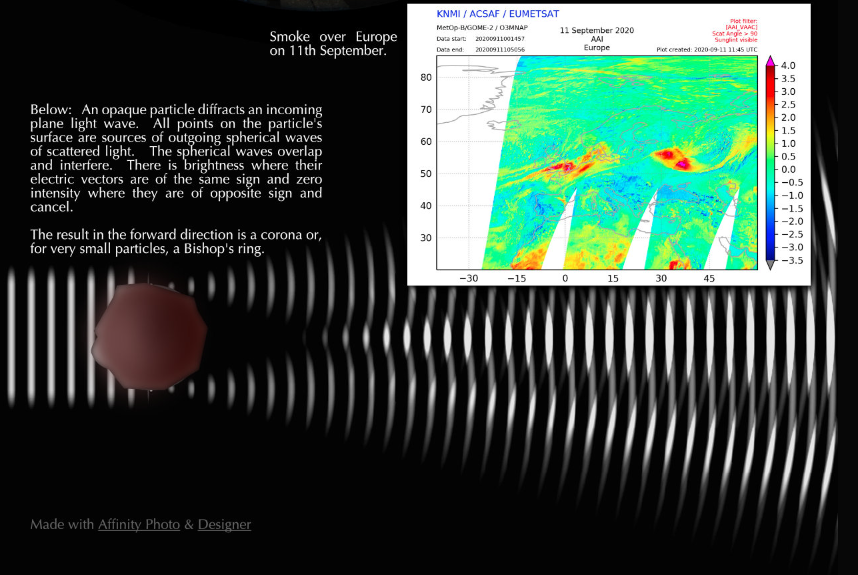Bishop's Ring over Europe from california Wildfire Smoke
Bishop's Ring over Europe from California Wildfire Smoke
In September, atmospheric optics expert Peter-Paul Hattinga Verschure captured a stunning image of the Bishop's ring in Deventer, The Netherlands. The Bishop's ring is the central part of a large corona, surrounded by an aureole edged with brownish yellow and red hues. This captivating phenomenon is created by the diffraction of sunlight by tiny particles, approximately 1 micron in size.
One intriguing aspect of the Bishop's ring captured by Hattinga Verschure is its likely connection to smoke from Californian wildfires. Satellite imagery revealed that the smoke traveled across the United States and the Atlantic Ocean, reaching Europe. The presence of small smoke particles makes them ideal candidates for generating Bishop's rings. However, it is worth noting that particles from volcanic eruptions and desert sand can also produce similar optical phenomena.
To better understand the mechanism behind the formation of the Bishop's ring, let's delve into the physics of diffraction. When an incoming plane light wave encounters an opaque particle, it diffracts and creates outgoing spherical waves of scattered light from all points on its surface. These spherical waves overlap and interfere with each other. In regions where the electric vectors of the overlapping waves have the same sign, brightness is observed. Conversely, regions where the electric vectors have opposite signs experience cancelation, resulting in zero intensity.
The forward direction of this interference pattern gives rise to a corona or, in the case of very small particles, a Bishop's ring. The size of the particles plays a crucial role in determining the appearance of the optical phenomenon. In the case of Bishop's rings, the particles are approximately 1 micron in size, allowing for intricate interference patterns and the formation of a clearly defined ring.
The occurrence of Bishop's rings from Californian wildfire smoke over Europe on September 11th highlights the global reach and impact of atmospheric phenomena. This particular event serves as a reminder of the interconnectedness of our planet's atmospheric systems. The smoke particles, propelled by prevailing winds, can traverse vast distances, carrying with them the potential to create mesmerizing optical displays.
It is fascinating to consider the diverse sources of particles that can generate Bishop's rings. While wildfire smoke has been implicated in this instance, volcanic eruptions and desert sand can also contribute to the formation of these optical phenomena. Each particle brings its unique characteristics, influencing the color and intensity of the Bishop's ring. The interplay between these particles and sunlight creates a spectacle that captivates observers worldwide.
The discovery and documentation of Bishop's rings over Europe from California wildfire smoke highlight the importance of atmospheric optics research. By studying these phenomena, scientists gain insights into the composition and behavior of particles suspended in our atmosphere. Furthermore, these observations contribute to our understanding of atmospheric transport processes and the far-reaching effects of natural events.
In conclusion, the Bishop's ring over Europe from California wildfire smoke serves as a remarkable example of the intricate interplay between light and particles in our atmosphere. This optical phenomenon, captured by Peter-Paul Hattinga Verschure, showcases the global nature of atmospheric optics and its ability to transcend geographical boundaries. By expanding our knowledge of these phenomena, we gain a deeper appreciation for the wonders that surround us and the interconnectedness of our planet's atmospheric systems.

Bishop's Ring
Imaged by atmospheric optics expert Peter-Paul Hattinga Verschure at Deventer in The
Netherlands September. The Bishop's ring was likely produced by Californian wildfire smoke.
The Bishop's ring is the centre part of a huge corona. An aureole edged with brownish
yellow and reds. Tiny particles -1 micron or so in size diffract sunlight to produce it.
The source of the particle producing this one? Wildfire smoke from the US West Coast. Satellite imagery detected the smoke carried easterly across the US and Atlantic Ocean.
Small smoke particles are ideal candidates to generate Bishop's rings. Particles from volcanic
eruptions and desert sand make them too.
Smoke over Europe on 11th September.

Below: An opaque particle diffracts an incoming plane light wave. All points on the particle's
surface are sources of outgoing spherical waves of scattered light. The spherical waves overlap and interfere. There is brightness where their electric vectors are of the same sign and zero intensity where they are of opposite sign and cancel.'
The result in the forward direction is a corona or, for very small particles, a Bishop's ring.
Note: this article has been automatically converted from the old site and may not appear as intended. You can find the original article here.
Reference Atmospheric Optics
If you use any of the definitions, information, or data presented on Atmospheric Optics, please copy the link or reference below to properly credit us as the reference source. Thank you!
-
<a href="https://atoptics.co.uk/blog/bishops-ring-over-europe-from-california-wildfire-smoke/">Bishop's Ring over Europe from california Wildfire Smoke</a>
-
"Bishop's Ring over Europe from california Wildfire Smoke". Atmospheric Optics. Accessed on November 26, 2024. https://atoptics.co.uk/blog/bishops-ring-over-europe-from-california-wildfire-smoke/.
-
"Bishop's Ring over Europe from california Wildfire Smoke". Atmospheric Optics, https://atoptics.co.uk/blog/bishops-ring-over-europe-from-california-wildfire-smoke/. Accessed 26 November, 2024
-
Bishop's Ring over Europe from california Wildfire Smoke. Atmospheric Optics. Retrieved from https://atoptics.co.uk/blog/bishops-ring-over-europe-from-california-wildfire-smoke/.